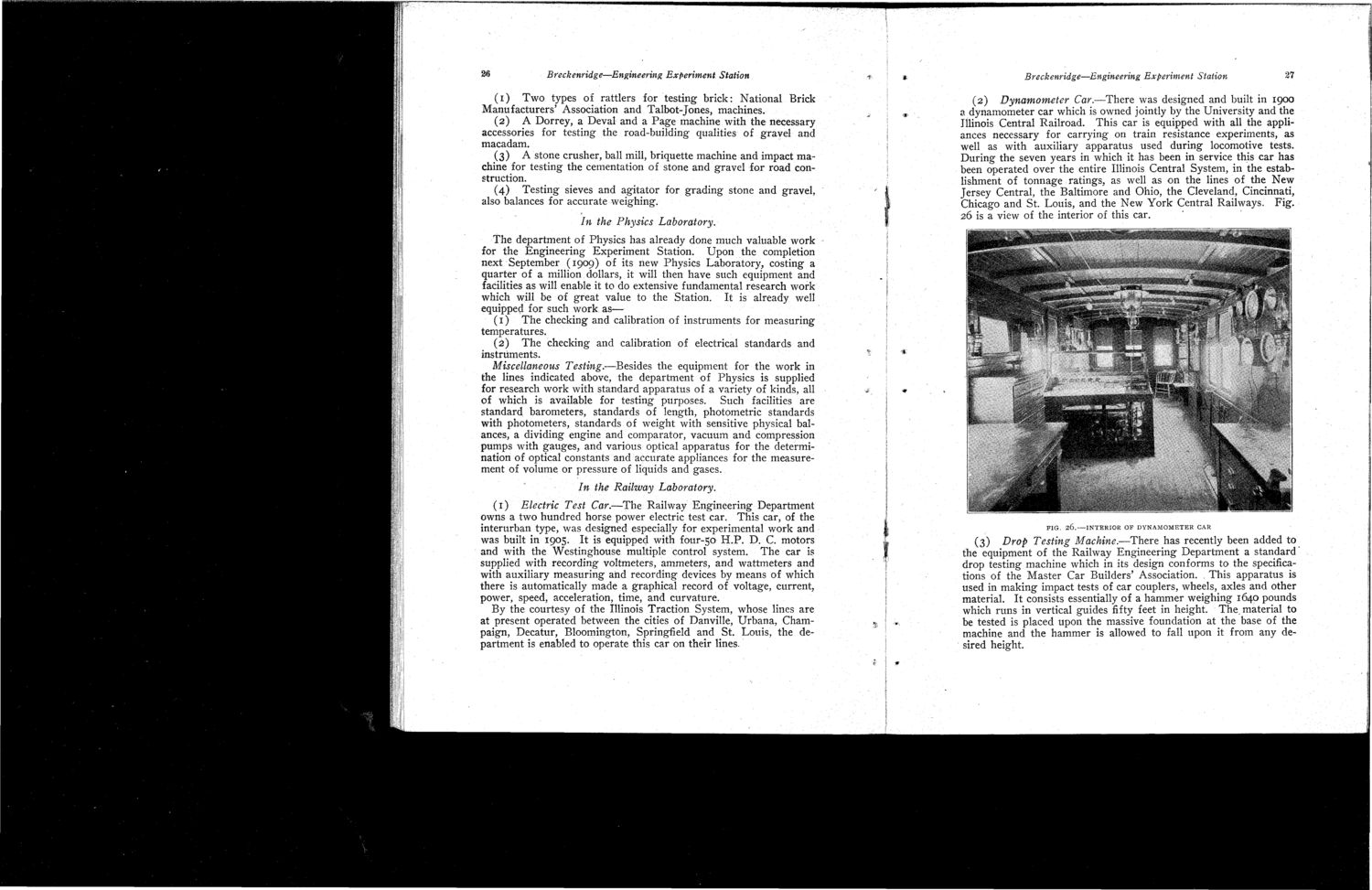| |
| |
Caption: Booklet - Engineering Experiment Station and Industry (1909)
This is a reduced-resolution page image for fast online browsing.

EXTRACTED TEXT FROM PAGE:
-26 Br•eckenridge—Engineering, Experiment Station Br eckenridge—-Engineering Experiment Station 27 ( i ) Two types of rattlers for testing brick: National Brick Manufacturers' Association and Talbot-Jones, machines. (2) A Dorrey, a Deval and a Page machine with the necessary accessories for testing the road-building qualities of gravel and macadam. (3) A stone crusher, ball mill, briquette machine and impact machine for testing the cementation of stone and gravel for road construction. (4) Testing sieves and agitator for grading stone and gravel, also balances for accurate weighing. In the Physics Laboratory. (2) Dynamometer Car.—There was designed and built in 1900 a dynamometer car which is owned jointly by the University and the Illinois Central Railroad. This car is equipped with all the appliances necessary for carrying on train resistance experiments, as well as with auxiliary apparatus used during locomotive tests. During the seven years in which it has been in service this car has been operated over the entire Illinois Central System, in the establishment of tonnage ratings, as well as on the lines of the New Jersey Central, the Baltimore and Ohio, the Cleveland, Cincinnati, Chicago and St. Louis, and the New York Central Railways. Fig. 26 is a view of the interior of this car. The department of Physics has already done much valuable work for the Engineering Experiment Station. Upon the completion next September (1909) of its new Physics Laboratory, costing a quarter of a million dollars, it will then have such equipment and facilities as will enable it to do extensive fundamental research work which will be of great value to the Station. It is already well equipped for such work as— (1) The checking and calibration of instruments for measuring temperatures. (2) The checking and calibration of electrical standards and instruments. Miscellaneous Testing.—Besides the equipment for the work in the lines indicated above, the department of Physics is supplied for research work with standard apparatus of a variety of kinds, all of which is available for testing purposes. Such facilities are standard barometers, standards of length, photometric standards with photometers, standards of weight with sensitive physical balances, a dividing engine and comparator, vacuum and compression pumps with gauges, and various optical apparatus for the determination of optical constants and accurate appliances for the measurement of volume or pressure of liquids and gases. In the Railway Laboratory. (1) Electric Test Car.—The Railway Engineering Department owns a two hundred horse power electric test car. This car, of the interurban type, was designed especially for experimental work and was built in 1905. It is equipped with four-50 H.P. D. C. motors and with the Westinghouse multiple control system. The car is supplied with recording voltmeters, ammeters, and wattmeters and with auxiliary measuring and recording devices by means of which there is automatically made a graphical record of voltage, current, power, speed, acceleration, time, and curvature. By the courtesy of the Illinois Traction System, whose lines are at present operated between the cities of Danville, Urbana, Champaign, Decatur, Bloomington, Springfield and St. Louis, the department is enabled to operate this car on their lines. FIG. 2 6 . — I N T E R I O R OF DYNAMOMETER CAR (3) Drop Testing Machine.—There has recently been added to the equipment of the Railway Engineering Department a standard drop testing machine which in its design conforms to the specifications of the Master Car Builders' Association. . This apparatus is used in making impact tests of car couplers, wheels, axles and other material. It consists essentially of a hammer weighing 1640 pounds which runs in vertical guides fifty feet in height. The^ material to be tested is placed upon the massive foundation at the base of the machine and the hammer is allowed to fall upon it from any desired height.
| |